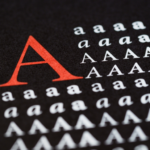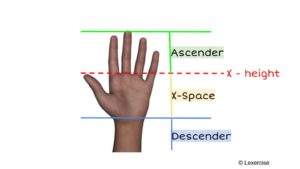On Fonts, Fluency & Dyslexia
Written by Sandie Barrie Blackley, MA/CCC
Published on July 23, 2018
In our post on dysgraphia research, we discussed the importance of handwriting for children with dyslexia, listening comprehension disorder, and dysgraphia. In this post, we’d like to take that one step further and talk about fonts and fluency.
First, let’s define what a font is:

font – “an assortment or set of type or characters all of one style and sometimes one size.”
Most of us are familiar with the common fonts that appear on our computer screens (Arial, Times New Roman, etc.), but there are in fact hundreds of thousands of current and historic fonts.
Fonts are made up of characters—letters, numbers, and symbols. Specific details of a font, such as X-height, ascenders, descenders, and ligatures, give the font its unique appearance. (The Lexercise Live Broadcast In Appreciation of Handwriting does a good job of illustrating these details.)
In today’s typical classroom, children are taught to print capital letters, each one a separate object. Eventually, like wood blocks, the letters get lined up and turned into words… if all goes well. Children with language-processing impairments often have difficulty getting the letters/blocks lined up and perceiving them as words that can be seen, heard, spoken, connected, and understood.
At Lexercise, rather than treating letters as stand-alone objects, we view them as symbols, each made distinctive by its unique movement pathway.
Connect with a Dyslexia Teletherapist for a Free Consultation
Long before the printing press, documents had to be produced by hand, legibly, efficiently, and in a way that minimized fatigue. A type of script handwriting style called Chancery Script was the handwriting style developed for this purpose. Its appeal and usefulness continue to the present day.
Lexercise selected a script letter formation style for teaching and practice resources because it approximates the way young students write lowercase letters—a natural “dance of the pen” that is individual, creative, and multisensory. A script handwriting style focuses on the explicit and ergonomic movement path for forming each letter, natural ligatures between letters, and the development of a personal “hand” as opposed to prescribed letter shapes.
Recent brain-imaging research supports teaching letter formation as a movement path, rather than as static shapes, and connecting the movement path for each specific letter to the letter’s symbol-sound connection (Dehaene, 2013).
“Using a simultaneous multisensory structured approach appears the most effective instructional approach for literacy for individuals with dyslexia. This approach includes emphasizing the visual, auditory, and kinesthetic pathways of learning simultaneously.” (Hoffmeister, 2016)
For example, “confusable” lowercase letters like b and d are dramatically different in terms of their movement pathways and their entry and exit strokes. Children overcome the tendency to reverse and confuse letters (in reading and writing) most efficiently when they are explicitly taught the movement pathway for writing each lowercase letter as opposed to an approach that focuses on capital letters and copying static shapes.
In structured, explicit, sequential handwriting practice, a child sees, hears and feels the letter formation: a critical step toward fluency.
If you have questions about your child’s language processing, contact Lexercise today at 1-919-747-4557 or info@lexercise.com.
– – – –
References
Dehaene, S. Reading the Brain. A video of a lecture delivered at the Peter Wall Institute, Chan Centre on April 7, 2012. (60 minutes)
Hoffmeister, Stephanie, “The impact of font type on reading” (2016). Senior Honors Theses. 505.
Łuniewska, M., Wójcik, M., and Jednoróg, K. (2021). The effect of inter-letter spacing on reading performance and eye movements in typically reading and dyslexic children,
Learning and Instruction, 101576. https://doi.org/10.1016/j.learninstruc.2021.101576
Improve Your Child’s Reading
Learn more about Lexercise today.
Schedule a FREE
15-minute consultation




Leave a comment